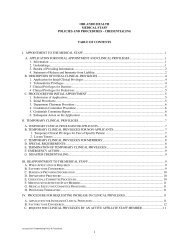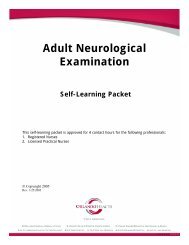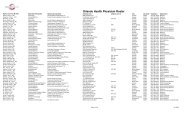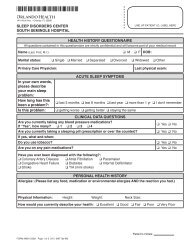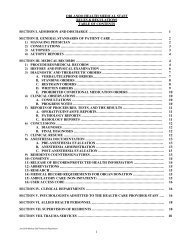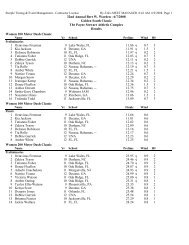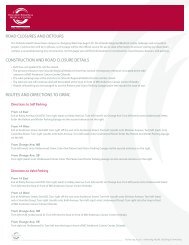Advanced Hemodynamics - Orlando Health
Advanced Hemodynamics - Orlando Health
Advanced Hemodynamics - Orlando Health
Create successful ePaper yourself
Turn your PDF publications into a flip-book with our unique Google optimized e-Paper software.
<strong>Advanced</strong> Hemodynamic Monitoring<br />
the needs of the body. For example, an 80 pound elderly woman will need less blood than a 350<br />
pound young, male linebacker. To account for these differences the cardiac index can also be<br />
calculated. The cardiac index (CI) is the cardiac output adjusted for body surface area. The normal<br />
value for this is between 2.5 and 4.2 liters of blood per minute, per square meter of body surface<br />
area. The equation to determine cardiac output is seen below:<br />
Cardiac output = heart rate x stroke volume*<br />
*HR= beats per minute<br />
*Stroke volume= amount of blood ejected from the ventricles in one beat.<br />
Heart Rate<br />
Most non-diseased hearts can tolerate heart rate changes from 40-170 beats per minute. As cardiac<br />
function becomes increasingly compromised this range will become narrower. The heart rate and<br />
the stroke volume should work like a see-saw. If one goes up, the other should go down, and vice<br />
versa. The most common change is related to low stroke volume or increased tissue oxygen<br />
demands which cause the heart rate to increase to compensate for the change. This is termed<br />
compensatory tachycardia.<br />
Stroke Volume<br />
Stroke volume (SV) is the amount of blood ejected from the left ventricle each time the ventricle<br />
contracts. The stroke volume is the difference between end-diastolic volume (EDV), the amount of<br />
blood in the left ventricle at the end of diastole, and end-systolic volume (ESV), the blood volume<br />
in the left ventricle at the end of systole. Normal stroke volume is between 60 and 130 ml/beat. The<br />
equation for SV is seen below:<br />
SV= EDV-ESV<br />
When stroke volume is expressed as a percentage of the end-diastolic volume, it is referred to as the<br />
ejection fraction (EF). A normal left ventricular EF is approximately 55- 70%.<br />
The three main factors that influence the stroke volume are the remaining three components that<br />
determine cardiac performance: preload, afterload, and contractility. These three components are<br />
inter-related. If one is affected, so will it affect one or more of the others.<br />
Preload<br />
The term preload refers to the amount of end-diastolic stretch on the myocardial muscle fibers. This<br />
in turn is determined by the volume of blood filling the ventricle at the end of diastole. In essence,<br />
the greater the filling volume, then the greater the stretch of the myocardial muscle fibers. The more<br />
the myocardial muscle fibers are stretched, the greater the force of the myocardial contraction and<br />
potentially the greater the stroke volume to a physiological limit. Although the stretch of the<br />
myocardial muscle fibers is the most accurate method for determining preload, currently there is not<br />
a way to measure myocardial fiber length. Consequently, it has become the standard to estimate this<br />
value by evaluating the filling volumes using equipment such as central venous pressure monitoring<br />
or pulmonary artery catheter values which will be discussed later. It is clinically acceptable to<br />
Copyright 2010 <strong>Orlando</strong> <strong>Health</strong>, Education & Development 4




